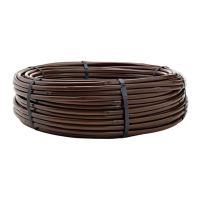N E T A F I M T E C H L I N E
®
C V D E S I G N G U I D E
N E T A F I M T E C H L I N E
®
C V D E S I G N G U I D E
Determining Techline CV Application Rate
Application Rate (inches per hour) =
231.1 x Dripper Flow Rate (GPH)
Dripperline Row Spacing (inches) x Techline CV Dripper Spacing (inches)
Example:
• Dripperline Row Spacing = 17.3” apart
• Techline CV Dripper Spacing = 18”
• Dripper Flow Rate = .6 GPH
231.1 x .6 (GPH)
17.3 inches x 18 inches
= .45 inches per hour
BASIC
DESIGN
STEPS
(continued)
PRESSURE & FLOW CHECKS:
• One of the best means of ensuring a Techline CV zone is operating properly is to test the pressure at
regular intervals.
• By taking and recording the pressure while the zone is running, you can ensure that the zone is
working as installed.
• Take the reading as far away from the source as possible to ensure that pressures throughout the rest
of the zone are at least that high.
• If readings are lower than normal, a line break, clogged filter, dirty remote control valve, clogged PRV,
or reduced line pressure are possible causes.
NOTE: Always take the readings at the same time of day, from the same spot. This reduces the chance
of faulty readings due to other factors.
• If a water meter is available, check the flow of each zone.
• Record the information at least once per year on a “System Inspection Checklist” (an example is
provided on page 37).
CALCULATING PRECIPITATION RATES:
• Method 1: See the “Techline CV Application Rate Tables” on page 26.
• Method 2: If there is some variation in your design, (for instance, when we had to decrease the
distance between the rows in our earlier example) then rely on the formula below.
CAUTION: Though the precipitation rates of rotors, fixed sprays and Techline CV can be very close in
many situations, we do not recommend tying dripperline into spray or rotor zones. Techline CV has an
irrigation application rate efficiency greater than sprays or rotors. Even when calculations make it appear
that the application rates are the same, a Techline CV zone will actually be delivering more water since
none of it is evaporating or landing where it canʼt be used.

